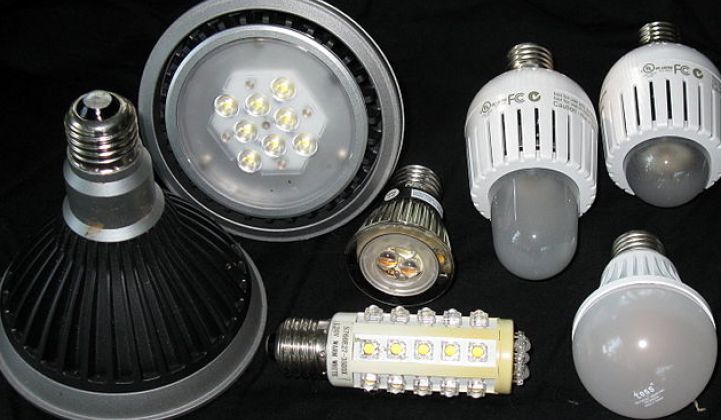Smart, networked lighting may the next big market for building energy efficiency and automation technology. But to date, that market has been a battleground of proprietary technologies: different networks, linking up different lighting systems, in a landscape that leaves little room for future mix-and-match interoperability.
That’s what makes the new partnership between lighting networking startup Daintree Networks and LED maker LG Electronics USA a noteworthy one. On Tuesday, the two companies announced they’ve teamed up to sell LG’s LED lighting fixtures that run on Daintree’s smart lighting control platform. It’s not the first such combination of networking smarts embedded in LED lights. But it’s one of the first that comes in a standards-based flavor.
“We’re not actually embedding any proprietary technology in our product to make this happen,” Sean Lafferty, director of LED lighting for LG Electronics USA, said in an interview. Instead, “we’re providing a ZigBee wireless controller embedded in our products,” which is the wireless protocol that Daintree uses to network LED drivers and lighting ballasts, remote-control thermostats and other indoor smart devices.
In other words, “we’re embracing a model where we’ll have interoperability,” he said. That’s not ubiquitous interoperability, of course -- ZigBee is one of several low-power wireless mesh networking standards vying for dominance in the commercial building space. But in the almost completely proprietary smart lighting landscape, it’s an outlier.
Consider the recent spate of announcements from big lighting vendors like Cree and Philips, both of which are promoting their own proprietary wireless mesh-embedded LED control platforms. Likewise, the majority of lighting network technology startups out there, such as Digital Lumens, Enlighted, Redwood Systems (bought by CommScope) and Adura (bought by Acuity), are offering technologies that, while sometimes based on standard wireless technologies, tend to be tweaked in one way or another that renders them non-interoperable.
There are a number of good reasons to embed more than a ZigBee chipset in smart lights. Enlighted, for example, cites the distributed intelligence of its smart lighting nodes, complete with their own array of sensors and processing and memory enough to continue following schedules and automated response patterns when the network is down, as a better alternative to an architecture that relies on constant network connectivity for effective operation.
At the same time, going with a standard, off-the-shelf style model should allow far more flexibility and much lower cost of entry for a broader array of potential partners, Daintree CEO Danny Yu said. “What’s the highest impact, with the lowest cost, to deliver true end-user value? By focusing on wireless connectivity, that’s what we’ve done here.” That’s already happening via chipset partners like Marvell, which is embedding ZigBee connectivity into LED driver units for vendors Orama and Samsung.
Eventually, of course, open standards should allow customers to pick and choose among multiple vendors, breaking open what might otherwise end up being a very proprietary landscape, he said. That's the goal that led Daintree to open its ControlScope firmware to multiple partners back in 2012, and it's "something that end customers really care about -- the fact that all device manufacturers have to open their base to all comers, rather than locking customers down in some proprietary manner,” he said.
Whichever side of this battle one chooses, there’s no doubt that embedded wireless controls are the wave of the future, compared to the retrofit-style networking we’ve seen to date. Daintree and LG estimate that embedding controls in the factory cuts the cost of a deployed networked light by 85 percent. However, LG is still offering networked retrofit kits, along with its commercial-industrial LED “troffer” ceiling light fixtures, for customers that don’t want to replace their lights completely -- yet another sign that it’s early days yet in the networked lighting evolution.
As for LG’s choice to go with a simple wireless connection versus a more costly distributed intelligence-style LED fixture, “We are positioning ourselves beyond the median in features and functions, but at a price point that makes sense,” Lafferty said. This could become increasingly important as networked lights move beyond the larger-scale commercial and industrial lighting space, where established sales channel partnerships could sustain a set of proprietary technologies based on premium service and functionality.
Once networked LEDs start moving into broader residential and small to mid-size commercial markets, it’s harder to see proprietary wireless systems competing against the cost and flexibility advantages of standards-based technologies. "Right now, we’re primarily focused on the commercial and industrial space," he said, "but we’re seeing a lot of regulation on the consumer side to leverage all the features and functions of a networked lighting control scenario."
Of course, there’s still a way to go on this front -- LG’s new ZigBee-networked lights require a Daintree-certified installation partner to get the system up and running at present, he noted. Even so, compared to a fully proprietary system, it offers a lot more future flexibility -- including the opportunity for customers to choose LG competitors' products to mix and match with their initial LG LED-centered network.
"It's a little bit surprising to say we're the only ones doing it, but that's the situation we're in," he said. “We’re happy to work in an interoperable way, and we’re really hoping the industry gets on board, and stops trying to provide proprietary solutions to ubiquitous problems.”



